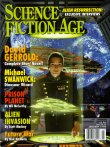 |
MAGAZINES
|
 |
 |
Profiles of January 1998 Issues
 |
Interzone January 1998
A special Christmas issue (guest-edited by Paul Brazier), with a nanotech story by Pat Cadigan, an Alpine ghost story by Graham Joyce, and a provocative sample of interactive fiction by Geoff Ryman that combines ''I Love Lucy'' and the Nativity story. • Pat Cadigan is interviewed. She recently relocated to London, abandoned Parasite, and has Bunraku scheduled for publication. Next up: a book about the film Lost in Space. • Keith Knight surveys half a dozen sf films of 1997, and understands why Hollywood doesn't attempt to adapt more prepublished works of sf.
(posted 12 Feb 98)
|
 |
The New York Review of Science Fiction, January 1998
Rudy Rucker relates cyberpunks to beatniks (matching himself to William S. Burroughs), and offers insights into the latest novels by his cyberpunk fellows: Gibson's Idoru, Shirley's Silicon Embrace, and Sterling's Holy Fire. • Eleanor Arnason, responding to Norman Spinrad's woes, considers herself as an example of a writer whose career has been ruined by the current state of publishing. • Michael Swanwick relates a true incident of a man who impersonated a fictional character, Swanwick's own Jane from The Iron Dragon's Daughter, and wonders why. • Michael Andre-Driussi traces connections among the works of Jack Vance, and constructs a future history time-line.
(posted 12 Feb 98)
|
 |
F&SF January 1998
A lengthy novella in Sheila Finch's lingster series and a Bradburyesque parable by Dale Bailey highlight the fiction. Part 1 of Gregory Benford's examination of the greenhouse problem outlines two methods of attack: extreme conservation, or compensatory actions like planting trees. (Part 2, next month, promises more imaginative, and inexpensive, approaches.) Kathi Maio's film review column examines Hollywood's compromises in bringing Carl Sagan's Contact to the screen.
(Wed 24 Dec)
|
 |
Playboy, January 1998
Includes a story ''by Arthur C. Clarke and Stephen Baxter'' that is apparently a canny tribute by Baxter to the career and themes of Clarke.
(Wed 24 Dec)
|
 |
Science Fiction Age, January 1998
A novella by David Gerrold in the mode of a Heinlein juvenile but with social themes of the 90s. Other fiction describes a virtual tour of Hell and a cat conspiracy in Dr. Seuss style rhyme. The Science dialogue, between R. Michael Hord and Charles Sheffield, is about computers of the future, but its most unsettling perspective comes in recalling the days of vacuum tube machines that were so unrealiable that complex programs were run multiple times to account for the inevitable errors due to hardware. (Whereas these days, an astronomically rare error in the Pentium chip is Big News.) The Gallery features art by Robert F. Walters, with commentary by Michael Swanwick. (SF Age readers note: typographical error in this issue.)
(Wed 24 Dec)
|
 |
Analog, January 1998
A First Contact issue, with an article by Michael A. G. Michaud about the ''Declaration of Principles Concerning the Sending of Communications to Extraterrestrial Intelligence'' and fiction on the theme by Rick Shelley and Ben Bova. Jeffery D. Kooistra's Alternate View column cautions against underestimating the cleverness of the ancient engineers responsible for monuments like Stonehenge. Stanley Schmidt's editorial considers the typical succession pattern of company leadership -- idea types, then managers, then accountants -- and wonders if this pattern also applies to entire cultures. (Posted Mon 1 Dec 97)
|
 |
Asimov's, January 1998
Hard SF of the month: Geoffrey A. Landis's ''Approaching Perimelasma'', a spectacular descent into a black hole by a clone on a suicide mission. Robert Reed's big novella ''Mother Death'' continues a far-future saga of a galaxy dominated by powerful families. Kandis Elliot provides a surreal take on overdevelopment and population control in ''Evolution in Guadalajara''. And in his column, Robert Silverberg meets great whales. (Posted Fri 28 Nov 97)
|
|
 |



